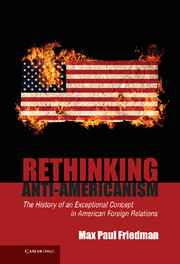3 - The Specter Haunting Europe
Anti-Americanism and the Cold War
Published online by Cambridge University Press: 05 November 2012
Summary
I am not anti-American. I don't even know what the word means.
– Jean-Paul SartreWorld War II and its aftermath laid bare the stark difference between correlation and causality with regard to anti-Americanism and world affairs. The ugliest caricatures, the most vicious kinds of propaganda expressed during this most destructive of wars turned out to be transient epiphenomena of an international clash. Hostile expression directed toward the United States, unsurprisingly, intensified in enemy countries and cooled among America's allies, because geopolitical conflicts drove anti-American sentiment, not vice versa. When the war was over, the images of brutish and corrupt Americans that had abounded in the propaganda of the Axis countries rapidly faded, giving way within a few years to strong pro-American sentiment among the conquered populations of Germany and Japan who now depended on U.S. power for their protection. “Anti-Americanism” in these countries turned out to have been a superficial, temporary occurrence: an effect, not a cause, of international conflict.
The sweeping transformation of the international system and American politics by the Second World War brought lasting changes to the function of “anti-Americanism” in that system and in those politics. During the war, the United States out of necessity had allied itself with the world's leading Communist power, while the war marked the high-water point of right-wing anti-American ideology overseas. After the war was over, global political and economic competition would no longer align the United States against far-right powers but rather against those on the far left. That transition completed the decisive shift in hostile sentiment, broadly speaking, from rightist movements to leftist movements by mid-century. The Cold War that followed WWII split Europe and divided the world, according to the rhetoric of the superpowers, into two camps, globalizing the ideological arena in which many Americans would come to see criticism of the United States as a sign of alignment with its rival. As the nuclear stalemate froze armed conflict in Europe, the United States sought to thwart real or imagined Soviet meddling through a comprehensive strategy of formal alliances, foreign aid, propaganda, covert operations, and military intervention. President Harry Truman, in what would come to be known as the Truman Doctrine, promised to fight Communism anywhere in the world – a vast expansion of the sphere of American interests.
- Type
- Chapter
- Information
- Rethinking Anti-AmericanismThe History of an Exceptional Concept in American Foreign Relations, pp. 87 - 122Publisher: Cambridge University PressPrint publication year: 2012



